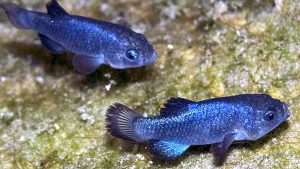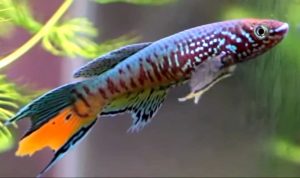Killifish are a group of egg laying tooth carps that comprise over 1270 species from various families including Aplocheilidae, Cyprinodontidae, Fundulidae, Profundulidae, Valenciida, and Rivulidae. Of the 1270 species discovered, about 350 of these are found within the equatorial belts throughout the world. The largest family Rivulidae, contains over 320 of the known species.
Although some of the specialized species of Killifish that have lifespans no longer than 9 or 10 months are found in temporary ponds, ditches, and puddles in the flood plains; most species of killifish have lifespans between 2 and 3 years, and are found in the lakes, ponds, rivers, and streams that have water throughout the year. These killifish (Cyprinodon, Fundulus and Rivulus) are common in the Americas, Africa, Asia (including Aphyosemion, Aplocheilus, Epiplatys, Fundulopanchax and Lacustricola) and Southern Europe (Aphanius).
In the Americas, Killifish can be found as far south as Argentina, and as far north as southern Ontario. They have also been found in Southern Europe, South Africa, as far south as Vietnam in Asia, the Middle East, and on several islands in the Indian Ocean. To date, no species of Killifish has been discovered in Antarctica, Australia, or in Northern Europe.
Killilfish are an extremely hardy species that can withstand a wide range of temperatures, salinities, and pollutants (such as organochloride fertilizers and pesticides) however, most killifish in their natural habitat live in a soft, slightly acidic water environment, with a pH of 6.0 to 6.8, and at temperatures between 71 to 80° F. Several species of Killifish are found only in extremely harsh ephemeral aquatic environments, where they have learned to survive and even thrive in periods of total or partial dehydration.
Although Killifish are primarily a freshwater species, they are also found in brackish to saltwater environments, and in areas where very few other fish species could survive.
The Devil’s Hole in Nevada, is an example of such an extreme environment that has a constant salinity and temperatures of 92 °F.
The Devils Hole pupfish (Cyprinodon diabolis) is the only natural resident of this 300′ deep cavern.
The eggs of many annual killifish species are like plant seeds, and rely on periods of drought in order for hatching to successfully take place. Their eggs, when entirely submerged in water will not survive more than a few weeks unless they are allowed to dry out to be later reconstituted.
This fact makes the sale and distribution of many annual killifish species a simple matter of mailing the eggs, without the need for water to the recipient, so they can be hatched out at a later date. A few species like adult Kryptolebias marmoratus can even survive out of water for several weeks. However, few Killifish fall into this category.
All 1270 species of Killifish can be separated into three distinct breeding categories:
- Annual species
- Semi Annual species
- Non Annual species
Annual species mature quickly and are generally short lived. In their natural habitats, they are found in small ponds, ditches, puddles, etc. that dry up for sometimes for extended periods of months to years. Killifish in this category tend to spawn continuously over extended periods to ensure the survival of the next generation.
A small number of eggs (usually only 3 to 5) are laid daily over a period of weeks, until the puddle or pond that they live in dries up. The eggs remain dormant in a state of hibernation known as diapauses, until the coming of the rainy season, when the puddle or pond again fills up with water to stimulate the hatching of the eggs. The eggs will hatch out in a matter of hours after the introduction of water. The young of annual killifish species grow to adulthood very quickly, and as soon as they reach maturity, they immediately begin their spawning activities to continue the life cycle. This process is ongoing until the pond or puddle dries up again and a new generation of killifish is produced.
Semi Annual species are generally longer lived than the annual species, and are found in areas that do not totally dry out in their natural habitat during the dry season. The ponds, ditches, and puddles that they are found in may hold water throughout the dry season and at the worst, dry out to a moist muddy bottom as the rains subside.
These killifish are substrate spawners that lay their eggs in the muddy sediment or organic debris at the bottom of the pond or ditch. As the rains subside, the water evaporates and the eggs remain damp and partially dry out in the sediment for periods of up to four months. When the rains return again, the eggs hatch out within a few days and the live cycle begins again.
Semi annual killifish species can be bred in an aquarium environment by simulating these conditions using peat moss, spawning mops, or Java Moss. Removing the eggs with the substrate, and partially drying them out for a period of 30 to 60 or more days (depending on species) essentially duplicates the spawning conditions. The eggs usually hatch out in a just few days after the introduction of water to the substrate.
Non Annual species are the longest lived of the three groups, and many (such as the Aphyosemion genus) can live up to five years or more in an aquarium environment. These fish live in small streams, ponds, and other permanent bodies of water that do not dry up during periods of drought. Non Annual killifish are harder to keep and are usually more challenging to breed.
Most of them are plant spawners that in an aquarium environment are bred using spawning mops or Java Moss. The eggs are incubated in water, not allowed to dry out, and usually hatch out in about 20 to 30 days depending on water temperature and species.
The largest killifish species can grow to almost 6 inches in length, but most killifish are less than 2 inches long.
Many klillifish species are as brightly colored as salt water fish and are prized by tropical fish keeping enthusiasts in the aquarium hobby.
Males are generally more colorful than females and often have incredibly elegant finnage. The females are usually larger than the males and are always less brightly colored.
Most killifish are territorial and will defend their areas from other males in the tank. They will vigorously mate with any available female in the area. When housed in an aquarium environment, it’s best to keep at least two or three females for every male in the tank. If you place more than a couple males in the same tank, it’s best to include at least three females for every male fish to minimize aggression.
In their natural habitat, the majority of Killifish are carnivorous and consume insect larvae, small invertebrates, mosquito larvae, worms, and zooplankton, however several species in the Americas do consume algae and other aquatic plant matter.
All killifish are great jumpers. In their natural habitats, they often jump from puddle to puddle as their environments shrink. In an aquarium environment, they need either a tightly fitting lid or some floating plants to discourage them from jumping out ot the tank.
Throughout the world, Killifish are prized by tropical fish keeping enthusiasts for their beauty, finnage, and breeding challenges, but they are also used as bait fish in many areas of the world, in laboratory studies in a variety of learning, aging, pigmentation, embryological, and endocrinological experiments, in inter tidal and nearshore pollution tolerance studies, and as a biological control agent to reduce mosquito populations in fresh and brackish waters.
If you have never come across any of these gorgeous little fish, it is probably because most tropical fish shops do not have a steady killifish supplier.
Unlike many other species of tropical fish, commercial suppliers are unable to mass produce killifish. Therefore, most species are bred by small breeders out of their homes and occasionally sold to commercial suppliers, or are wild caught.
Shipping wild caught specimens is an expensive proposition. Mainly because the males of most species fight when in close confinement, creating sometimes huge losses in shipments. Additionally, most killies are excellent jumpers and because many fish shop employees do not keep their tanks tightly covered, lots of expensive stock often ends up on the fish shop floor.
If you can find a pair of killifish in your local pet shop, you can be expected to pay in the neighborhood of $20 to $50 or more per pair.
Many tropical fish keeping enthusiasts breed killifish which are then distributed within killifish societies throughout the world. If you care to join one of these societies online, many of these specialty breeders will sell the eggs and occasionally the adults at reasonable prices, and may even give away the eggs to members.
One of the best source of killies is the Fish and Egg Listing (F&EL) found in the Business Newsletter of the AKA (American Killifish Association).



